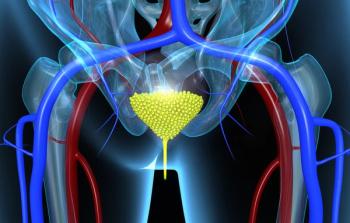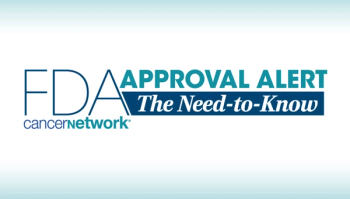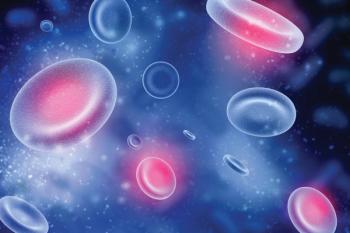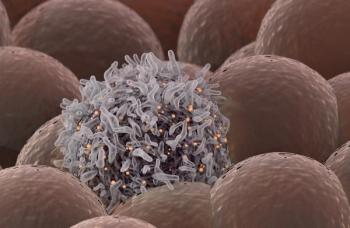
Novel TKI Exhibits Durable Responses in HER2-Mutated NSCLC
BAY 2927088 showed substantial response rates for patients with pretreated HER2-mutant non–small cell lung cancer.
Durable and substantial response rates were observed when BAY 2927088 was used to treat patients with pretreated HER2-mutant non–small cell lung cancer (NSCLC), according to results from cohort D of the phase 1 SOHO-01 trial (NCT05099172) presented at the
The objective response rate (ORR) was 72.1% (95% CI, 56.3%-84.7%), with a complete response rate of 2.3% and a partial response rate of 69.8%. The stable disease rate was 16.3%, and the progressive disease rate was 11.6%. The disease control rate (DCR) was 83.7% (95% CI, 69.3%-93.2%).
“These data support the ongoing investigation of BAY 2927088 in patients with advanced NSCLC harboring HER2 mutations,” Xiuning Le, MD, PhD, associate professor in the Department of Thoracic/Head and Neck Medical Oncology, Division of Internal Medicine at The University of MD Anderson Cancer Center, said during the presentation.
Assessment of BAY 2927088 is ongoing as part of the phase 3 SOHO-02 trial (NCT06452277).
Overall, 44 patients were included in the efficacy analysis of cohort D of the SOHO-01 trial. The recommended dose of BAY 2927088 was 20 mg by mouth. Cohort D included patients with HER2 activating mutations, HER2 exon 20 insertions, and those who were naïve to other targeted treatments.
The primary end points were safety, tolerability, and pharmacokinetics. Secondary end points included ORR that was investigator-assessed, progression-free survival (PFS), duration of response (DOR), and DCR.
A total of 63.6% of patients were female, 68.2% were Asian, and the median age was 62.0 years old. Additionally, 56.8% of patients had an ECOG performance status of 1, 70.5% had never smoked, and 95.5% had adenocarcinoma that was mixed or not otherwise specified.
The median time since the initial diagnosis was 16.0 months, and the median time since the most recent progression or relapse to the first administration of study treatment was 1.5 months.
Regarding HER2 mutations, the most common was YVMA insertions (70.5%) followed by other (22.7%) and point mutations (6.8%). Of note, 81.8% of patients had no brain metastases at baseline, 45.5% received 1 line of previous anti-cancer therapy, and 56.8% received previous platinum and immunotherapy.
The median follow-up was 10.9 months, and at that time, 36.4% of patients were still receiving treatment. Overall, 31.8% of patients received treatment for more than 12 months, and the median duration of treatment was 7.1 months.
The median DOR was 8.7 months (95% CI, 8.7-not estimable [NE]), and the median PFS was 7.5 months (95% CI, 4.4-12.2). The subgroup analysis looked at all evaluable patients in cohort D (n = 43). Of those, 30 had HER2 YVMA insertions with an ORR of 90.0% (95% CI, 73.5%-97.9%). Additionally, 8 patients had brain metastases with an ORR of 62.5% (95% CI, 24.5%-91.5%).
Among patients with YMVA insertions, the median DOR was 9.7 months (95% CI, 5.5-NE), and the median PFS was 9.9 months (95% CI, 6.9-NE).
Any-grade treatment-related adverse effects (TRAEs) occurred in 95.5% of patients, and 43.2% had grade 3 or higher TRAEs. The most common in both groups was diarrhea (86.4% vs 25.0%). Additional any-grade TRAEs included rash (43.2%), paronychia (25.0%), nausea (25.0%), and vomiting (20.5%).
TRAEs leading to treatment discontinuation occurred in 6.8% of patients due to corneal epithelial microcysts (n = 1), reduced visual acuity (n = 1), abnormal hepatic function (n = 1), and dyspnea (n = 1). Dose reductions because of TRAEs occurred in 31.8% of patients.
Of note, 11.4% of patients had serious TRAEs including diarrhea (n = 1), duodenitis (n = 1), vomiting (n = 1), and abnormal hepatic function (n = 2). There was no grade 4 TRAEs but 1 grade 5 event relating to dyspnea. There were no reports of interstitial lung disease or pneumonitis.
Reference
Le X, Girard N, Janne PA, et al. Safety and efficacy of BAY 2927088 in patients with HER2-mutant NSCLC: expansion cohort from the phase I/II SOHO-01 study. Presented at the 2024 IASLC World Conference on Lung Cancer; San Diego, CA, September 7-10, 2024. PL04.03.
Newsletter
Stay up to date on recent advances in the multidisciplinary approach to cancer.






















































































